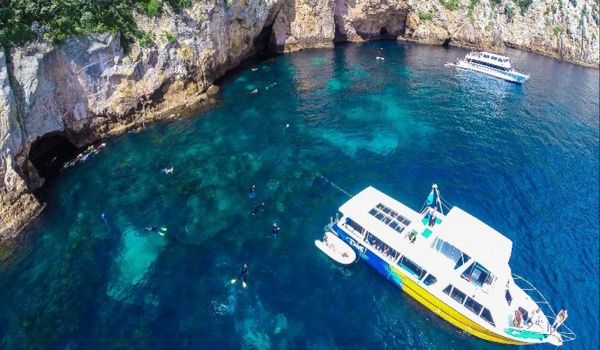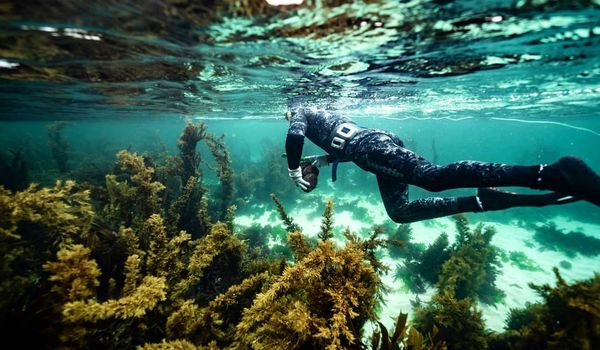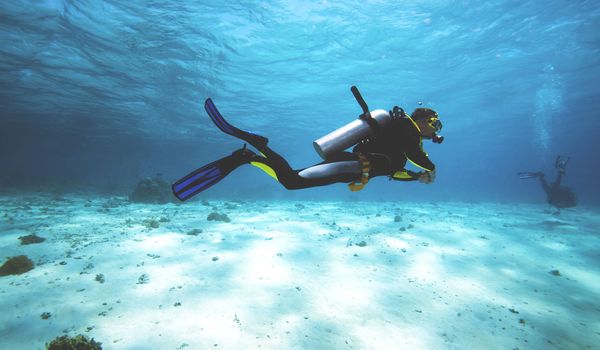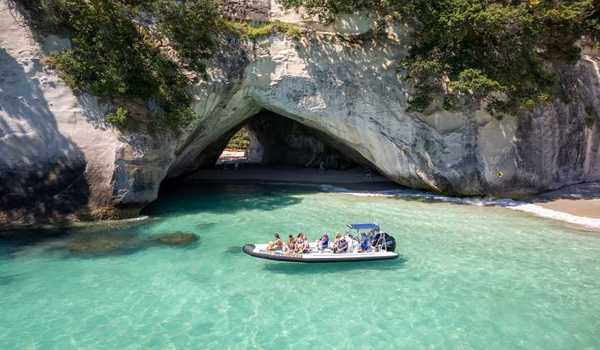🤿 Introduction to Scuba Dive in New Zealand
With its stunning landscapes and pristine waters, New Zealand offers scuba divers a world of underwater wonder.
From colorful reefs to historic shipwrecks, the country boasts a diverse range of dive sites catering to all experience levels.
Whether you’re a novice or a seasoned pro, New Zealand’s underwater world has something extraordinary to offer.
1. Poor Knights Islands
Nestled off the northern coast of the North Island, the Poor Knights Islands Marine Reserve is a UNESCO World Heritage Site known for its remarkable underwater scenery.
These islands, with their extensive network of caves, arches, and tunnels, create a captivating underwater labyrinth for divers.
Explore the colorful kelp forests and marvel at the diverse marine life, including large schools of fish, rays, and various species of sharks.
The Poor Knights Islands are renowned for their pristine waters and excellent visibility, making them a must-visit for divers looking to experience New Zealand’s marine magic.

2. Bay of Islands
The Bay of Islands, located in the northern part of New Zealand’s North Island, is a subtropical paradise that beckons divers worldwide.
With its warm waters, vibrant coral gardens, and an array of marine species, this region offers a unique diving experience.
Divers can explore historic shipwrecks like the Rainbow Warrior, which famously sank in 1985 and has since become a thriving artificial reef.
The Bay of Islands also provides an opportunity to encounter playful dolphins and, if lucky, spot the elusive seahorses that call this area home.

3. White Island
White Island, an active marine volcano in the Bay of Plenty, offers a truly otherworldly diving experience.
Descend into the underwater caldera, where you can observe bubbling underwater fumaroles and an eerie underwater landscape created by volcanic activity.
While diving here, you’ll encounter unique and hardy species of marine life adapted to extreme conditions, such as sulfur-loving bacteria and hydrothermal vent organisms.
White Island is an exceptional destination for advanced divers seeking a one-of-a-kind adventure.

4. Fiordland
In the remote and pristine waters of Fiordland, on the South Island, divers can explore one of the most dramatic underwater landscapes in the world.
Fiordland’s deep, cold fjords are home to remarkable creatures like black coral, sponges, and delicate sea anemones.
One of the highlights is the opportunity to see the rare and curious black coral trees, which can reach impressive sizes in these unique underwater canyons.
Fiordland’s underwater cliffs and pinnacles offer stunning photographic opportunities for divers looking to capture the raw beauty of New Zealand’s underwater world.

5. Goat Island Cave, Lake Taupo
New Zealand isn’t just about ocean diving; it also boasts captivating freshwater dive sites. Goat Island Cave in Lake Taupo is a surreal underwater cavern that beckons cave diving enthusiasts.
The cave, part of a submerged thermal spring system, offers crystal-clear waters and impressive limestone formations.
Divers can explore the passages and chambers, each with its unique charm.
Lake Taupo is the largest lake in New Zealand and a great destination for various water sports and recreation.

6. Kaikoura
Kaikoura, located on the northeastern coast of the South Island, is famous for its rich marine biodiversity and the opportunity to swim with dolphins and seals.
Divers can explore the Kaikoura Canyon, an underwater trench that plunges to considerable depths.
The canyon is home to an array of marine life, including blue sharks, dusky dolphins, and schools of pelagic fish.
If you love marine mammals, this is the place to be, as you can dive with dolphins and seals in their natural habitat.

7. The Canterbury Wreck
The Canterbury, a former naval vessel, was intentionally sunk in 2007 to create an artificial reef and a spectacular dive site. This wreck now rests off the coast of the Bay of Islands on the North Island.
The sunken ship has become a thriving habitat for various marine species, including schools of fish, rays, and octopuses.
Diving at the Canterbury Wreck is an adventure for novice and experienced divers, offering a unique opportunity to explore a sunken naval vessel.

8. Stewart Island
Stewart Island, located south of the South Island, is a haven for divers looking to encounter some of New Zealand’s iconic marine life.
The island is known for its kelp forests and abundant underwater creatures, including the New Zealand sea lion and the elusive yellow-eyed penguin.
Divers exploring these waters can also spot rays, seahorses, and the splendidly colorful nudibranchs that call Stewart Island home.
The island’s remote location ensures pristine diving conditions and encounters with unique species.

9. Tawhiti Rahi
Tawhiti Rahi, a small island off Great Barrier Island in the Hauraki Gulf, offers divers a stunning underwater environment teeming with marine life.
The island’s rocky coastline, kelp forests, and clear waters make it a favorite for divers seeking aquatic photography opportunities.
Divers can encounter a variety of species, including colorful wrasses, eagle rays, and the playful New Zealand fur seal.
Tawhiti Rahi is an excellent destination for divers looking to capture the vibrant marine life and unique underwater landscapes.

10. Cathedral Cove, Coromandel Peninsula
Cathedral Cove is famous for its breathtaking landscapes above water and the captivating underwater world it offers.
Located on the Coromandel Peninsula, this marine reserve is known for its underwater arches and caves.
Divers can explore the Cathedral Cove marine reserve and its unique topography while observing marine life like stingrays, snapper, and various fish species.
This is an ideal destination for novice divers and snorkelers who want to experience New Zealand’s underwater beauty.

11. Poor Knights Marine Reserve
The Poor Knights Marine Reserve deserves a second mention, as it’s simply too extraordinary to overlook.
Due to its immense biodiversity, this reserve is a top pick for divers in New Zealand.
The reserve is famous for its submerged arches, tunnels, and drop-offs, where divers can encounter everything from large schools of fish to the elusive and peculiar-looking frogfish.

12. The Mokohinau Islands
The Mokohinau Islands, situated off the northeastern coast of the North Island, offer a fantastic and remote diving experience.
The islands are known for their clear waters and the chance to encounter big marine species such as manta rays, sharks, and large pelagic fish.
The rugged underwater terrain, including underwater pinnacles and walls, creates an ideal habitat for diverse marine life.
The Mokohinau Islands are perfect for advanced divers seeking an adventurous and unspoiled aquatic environment.

🧑💻 Platforms to Book Scuva Dive Activities in New Zealand
For enthusiasts seeking to explore the underwater wonders of New Zealand, online platforms like Viator and BookMe offer convenient solutions to book scuba diving activities.
These platforms act as intermediaries, connecting eager divers with a variety of underwater experiences across the country.
🔎 Viator
Viator enables users to explore diverse options, read reviews, and securely book their preferred underwater experiences.
The platform’s global reach ensures a broad spectrum of scuba diving choices, and customer support services enhance the overall booking experience.
Advantages:
- Global selection of scuba diving activities.
- Transparent user reviews guide decision-making.
- User-friendly interface for easy navigation.
🔎 BookMe
With a focus on affordability and real-time availability, BookMe caters to budget-conscious travelers seeking immediate confirmation for their underwater explorations.
Its localized approach makes it a valuable resource for those specifically interested in scuba diving within New Zealand.
Advantages:
- Affordability with discounted local deals.
- Real-time availability for convenient scheduling.
- Focus on New Zealand-based experiences.
📝 Frequently Asked Questions (FAQ) about Scuba Dive in New Zealand
1. What makes New Zealand a popular destination for scuba diving?
New Zealand is renowned for its diverse marine life, clear waters, and unique underwater landscapes. Scuba divers are attracted to the country’s underwater caves and kelp forests, as well as the opportunity to encounter a variety of marine species.
2. What are some must-visit scuba diving locations in New Zealand?
Key scuba diving spots include the Poor Knights Islands, Milford Sound, the Bay of Islands, and the underwater caves of the Cathedral Cove. Each offers a unique diving experience, from vibrant marine life to stunning underwater rock formations.
3. Is scuba diving in New Zealand suitable for beginners?
Yes, New Zealand caters to divers of all levels. While some sites may have challenging conditions, many locations provide opportunities for beginners to receive training and explore shallower, more manageable depths.
4. What is the best time of year for scuba diving in New Zealand?
The scuba diving season in New Zealand is generally year-round, but the warmer months from November to April are popular. During this period, water temperatures are more comfortable, and marine life is often more active.
5. What type of marine life can I expect to encounter while scuba diving in New Zealand?
Divers can encounter diverse marine life, including colorful fish, seals, dolphins, rays, and even the occasional shark. The Poor Knights Islands, mainly, are known for their rich biodiversity.
6. Are there wreck dives in New Zealand?
Yes, New Zealand offers several wreck dives for enthusiasts. The HMNZS Canterbury near the Bay of Islands and the Rainbow Warrior near the Cavalli Islands are popular wreck dive sites with fascinating underwater histories.
7. Do I need a certification to scuba dive in New Zealand?
Certification is generally required for scuba diving in New Zealand. Ensure you have the qualifications from recognized diving organizations; some sites may require specific certifications based on the dive’s difficulty.
8. How is the visibility in New Zealand’s waters for scuba diving?
The visibility in New Zealand waters can vary depending on the location and weather conditions. Generally, coastal areas offer good visibility, ranging from 10 to 30 meters, providing clear views of the underwater landscapes.
9. Can I rent scuba gear in New Zealand?
Yes, most scuba diving operators in New Zealand offer equipment rental services. However, bringing your own equipment is advisable, especially if you have specific preferences or requirements.
10. Are there diving liveaboard options in New Zealand?
While liveaboard options are less standard than in some other diving destinations, liveaboard trips are available in New Zealand, especially for exploring more remote and pristine dive sites. Check with local operators for current offerings.
Conclusion
New Zealand’s underwater world is a diver’s paradise, offering many experiences for divers of all levels.
From the unique volcanic landscapes of White Island to the vibrant marine life of the Poor Knights Marine Reserve, there’s something to captivate every underwater enthusiast.
Whether you’re exploring underwater caves, diving with dolphins, or discovering the wonders of artificial reefs, New Zealand’s dive sites are a testament to the country’s rich marine diversity and natural beauty.










